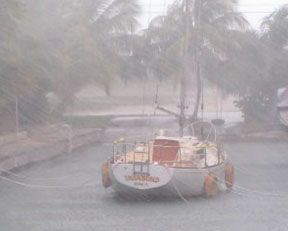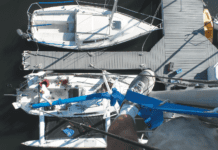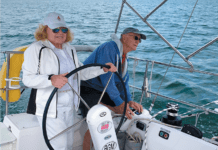In two months, the Atlantic hurricane season starts again. Miami is still recovering after a “minor” storm named Wilma blew through. Charley-towns, rows of identical trailers, still spread across Southwest Florida. New Orleans will never be the same.
In the face of such losses, gouged topsides, a snapped mast, or even the total loss of a boat seem inconsequential. Unless, of course, the boat happens to be yours. Or worse, that boat happens to be your home.

Don’t have insurance for your sailboat yet? Take a deep breath. We tried to hunt down reasonably priced insurance for a 1994 Catalina 36 mkII (See “The Insurance Gamble” in this month’s issue), and found it as rewarding as a day in the dentist’s chair … when the novocaine never kicks in.
If an insurance agent does finally come back with a quote, have a chair handy. And whether you’re renewing or applying for the first time, check your policy’s fine print with a microscope. Rather than raising premiums, insurers are adding more exclusions, raising the deductibles, or introducing clauses that can leave you high and dry—literally. Don’t be surprised if a policy excludes your dinghy, dodger, or any other hurricane fodder that some folks fail to secure for a storm.
Sad part is, a boat, unlike a coastal home, can be fortified against a hurricane without much investment. In fact, the most prudent step you can take will set you back little more than a few hours of engine time. Find the nearest hurricane hole and make a plan to get there early. Keep some old tires, chafing, and an extra spool of anchor rode at hand.
For two decades, Deborah Mitchell, who owns a Pearson 35 that she sails in Coconut Grove, Fla., has been doing just that. In that time, her trusty Vagabond has weathered storm after storm with little more than scratches. Mitchell has secured the boat a variety of ways—tied to shore, moored to concrete blocks, strapped to pilings—and no system has failed her.
Unfortunately, people like Mitchell—who has a 50-ton master’s license and five decades of ducking hurricanes in South Florida—are the ones who are paying for others’ mistakes. This year, her sailing club—which has it’s own insurance woes—began enforcing a long-standing rule that owners carry liability insurance. Never mind that Vagabond will be far from the club for the next hurricane, the rules—and the high premiums, it seems—apply to everyone.
Though Mitchell wasn’t too happy about it, she called around for liability coverage. The best quote was $450 per year, but she wasn’t eligible. Ironically, Mitchell’s boat didn’t qualify because it had never been insured. It’s a strange world indeed when you can’t pay good money for something you don’t even need.
Darrell Nicholson
Editor






































